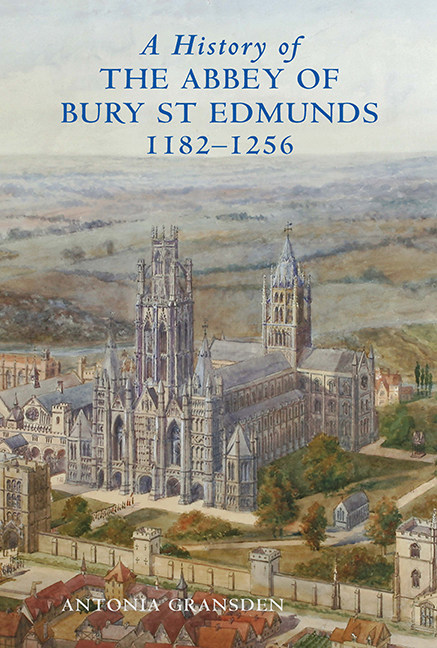Book contents
- Frontmatter
- Dedication
- Contents
- List of plates
- List of figures
- Preface
- Editorial Note
- Epigraph
- Acknowledgements
- Maps and plans (figures 1–9)
- Part I Samson of Tottington, Abbot 1182–1211
- 1 Samson's biographer, Jocelin of Brackland (de Brakelond), and his work
- 2 Samson's early life and career
- 3 Samson's election to the abbacy
- 4 The early years of Samson's abbacy and reform of estate management
- 5 Conflict with the convent
- 6 Relations with the town of Bury St Edmunds
- 7 Samson and secular law
- 8 Samson and the knights of St Edmund
- 9 Relations with the Angevin kings
- 10 Samson and the papacy
- 11 Samson as a builder
- 12 Religious and intellectual life under Samson
- 13 Samson's death and burial
- PART II The Abbey 1212–1256
- APPENDICES
11 - Samson as a builder
from Part I - Samson of Tottington, Abbot 1182–1211
Published online by Cambridge University Press: 29 April 2017
- Frontmatter
- Dedication
- Contents
- List of plates
- List of figures
- Preface
- Editorial Note
- Epigraph
- Acknowledgements
- Maps and plans (figures 1–9)
- Part I Samson of Tottington, Abbot 1182–1211
- 1 Samson's biographer, Jocelin of Brackland (de Brakelond), and his work
- 2 Samson's early life and career
- 3 Samson's election to the abbacy
- 4 The early years of Samson's abbacy and reform of estate management
- 5 Conflict with the convent
- 6 Relations with the town of Bury St Edmunds
- 7 Samson and secular law
- 8 Samson and the knights of St Edmund
- 9 Relations with the Angevin kings
- 10 Samson and the papacy
- 11 Samson as a builder
- 12 Religious and intellectual life under Samson
- 13 Samson's death and burial
- PART II The Abbey 1212–1256
- APPENDICES
Summary
The repair of derelict buildings and the construction of new ones under Samson have been mentioned above, but his fame as a builder rests primarily on the many building works within the abbey precincts, both ecclesiastical and domestic, which his enthusiasm initiated and his energy pursued. However, of all his projects the completion of the abbey church was paramount in his mind and his overriding ambition was to have the church consecrated. Jocelin ends a passage summarising Samson's merits with these words:
Samson performed these and similar deeds worthy of eternal record and renown, but he himself said that he would have achieved nothing in his lifetime unless he could bring about the dedication of our church. That done, he asserted, he would die content. He said he was ready to spend 2,000 marks of silver on the ceremony, provided the king was present and all was done with due ceremony.
Samson will have read in the De Miraculis Sancti Eadmundi (composed c. 1100) of Abbot Baldwin's failure to obtain permission from William Rufus for the consecration of the new (but unfinished) Romanesque church. He will also have known from his study of canon law that mass should not be celebrated in an unconsecrated place except in cases of ‘great necessity’, and that if there were any doubt as to whether a church had been consecrated or not, it should be consecrated even at the risk of it being consecrated twice. Doubt arose in the absence of reliable written record or of personal witnesses. There was certainly no written record that the abbey church had been consecrated after Baldwin's time. In Henry II's reign, probably in the late 1170s, a tract was composed recording the consecration of the numerous altars and chapels at St Edmunds and of the two parish churches (St James's and St Mary's) within the banleuca. The object of the tract was to demonstrate that the diocesan, the bishop of Norwich, had never consecrated at St Edmunds and, therefore, had no prescriptive right to do so. The tract was twice continued, first sometime after Samson had built the new infirmary, and then late in Simon of Luton's abbatiate (1257–79). It is clear from it that the abbey church itself had never been consecrated.
- Type
- Chapter
- Information
- A History of the Abbey of Bury St Edmunds, 1182–1256Samson of Tottington to Edmund of Walpole, pp. 83 - 93Publisher: Boydell & BrewerPrint publication year: 2007



